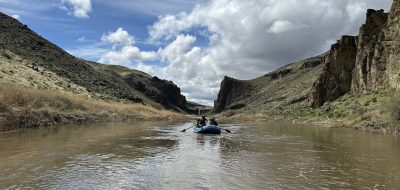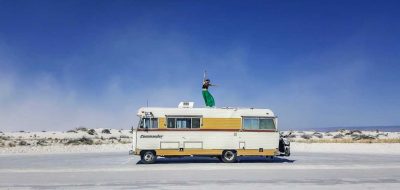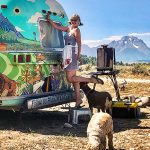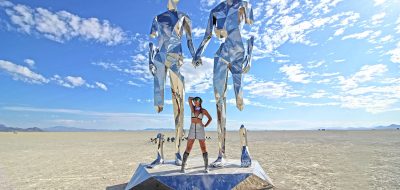 In response to my Snowbirds Quartzsite post last Saturday, Fred asked what you do for power if boondocking in Quartzsite for weeks at a time. I thought the question was good for a post of its own (I’ll return to Snowbird roosts next saturday.
In response to my Snowbirds Quartzsite post last Saturday, Fred asked what you do for power if boondocking in Quartzsite for weeks at a time. I thought the question was good for a post of its own (I’ll return to Snowbird roosts next saturday.
Boondocking (camping without sewer, water, or electrical hookups) is a skill you learn more about the more times you do it. If trash disposal (dumpsters), a drinking water tap, and a dump station are nearby, handling these boondocking limitations is just an inconvenience–having to pack up, hitch up, and drive, even if only a few hundred yards, then return and make camp again. This, for experienced boondockers, is just part of the experience and is handled in short order and with little fuss and difficulty. And every boondocker learns to conserve supplies and resources and limit waste in order to extend time between such moves.
With regard to power. Beginning boondockers invariably run their generator to recharge their batteries, as well as time the usage of electricity-hungry appliances to when they are running the generator, and to use less total power through conservation. They soon find out that even with these measures, running a generator to recharge depleted batteries takes a long time–hours–during which you and your neighbors–if you have any close by–must listen to the noise of a running generator, an alien sound in nature and not what most of us who go boondocking want to have to listen to. It’s fine for a few days (ask your neighbor when the best time would be to run your generator), but if you boondock often, you begin looking for alternate sources of energy.
That’s where solar and wind power come in. I have four solar panels on my motorhome roof and am able to supply all the power I need, lights, water pump, TV (which I have since stopped watching, though I did have enough power to run it), two laptop computers, etc. What my panels will not run, are the air-conditioner (which I seldom use anyway, preferring open windows), microwave (I’ll live without it), and my wife’s espresso machine (the real problem). Those appliances use too much electricity. I could however, add more panels to run these appliances but have opted not to. My wife has learned to make her afternoon latte on a stove top unit.
I have camped for weeks, even with some cloudy days thrown in (solar panels will still charge, though at a lower rate, when the sun is not out) without running the generator. In fact, several years ago my Onan 4.0 kw genset died after only 1069 hours, and was out of warranty, and would have cost almost as much to fix it as to buy a new one. At that time I decided to see what living without a generator would be like (I had no great love for it, anyway), added two more panels to my roof, and haven’t felt the need for a generator since. If I did, however, I would choose one of the small, quiet, portable Hondas or Kawasakis (NOTE: corrected to Yamaha, not Kawasaki, BD), that I could place well away from my motorhome).
Boondocking, however, can be a very personal experience, and one’s success at and enjoyment of it is dependent on how easily you can change wasteful habits, adapt to new procedures, and conserve resources. Those that are successful, tend to be those that value the freedom of camping choices in the great outdoors, yards, if not miles, from their nearest neighbor, dead silent nights (except for howling coyotes or scuffling armadillos), dark skies not dimmed by artificial lights filled with the bright stars of constellations, an absence of traffic roar from streets or highways, encounters with wildlife, birds, and strange plants, etc. For those, the minor inconveniences are well worth it. And think of all the campground charges you will save.
As I mentioned in my previous post, Mike Steffen has an excellent blog that delves further into the technical side of boondocking with his Solar Power for Your RV post and his Thoughts on Boondocking Part I post. You can also check out Greg Holder’s Web site at AM Solar. Greg’s company specializes in sizing solar systems for RVs.
Next Week: Snowbird Roosts on the Colorado River









Bob Difley
Billy – Sorry, my mistake. I meant Yamaha, not Kawasaki. Go to: http://www.a-chainsaw.com/yamaha-inverter-generator-ef1000is-p-237.html for a good retail price, and to http://www.amazon.com/Yamaha-000-Watt-Portable-Generator-EF1000ISC/dp/B00007E1MA for Amazon’s page that also includes a lot on choosing a generator and some buyer reviews.
Billy
I Google searched Kawasaki generators and found nothing. what are you talking about? a link would be nice.
Bob Difley
Bryce – Once while driving I kept hearing a thumping sound coming from somewhere in the front overhead. After several stops and my wife putting her ear to cabinets, walls, etc. I was unable to find the source of the noise. Several days later I was on my roof and found that I had lost one of the nuts holding a forward corner of one of my panels to the bracket, so that when traveling it thumped up and down on the roof. I replaced the nut, problem solved, no damage. However, I’ve always wondered about hail, falling pine cones and tree limbs, etc. but haven’t had any incidents or talked to other who have. Though, if I regularly traveled in areas that had golf ball size hail, I would either not be there during storms or park under some kind of overhead protection. As far as leaving them charging while driving, one of the functions of the controller is to limit charging as your batteries become fully charged, so leaving them charging should have no effect..
Regarding wind power, I have never used wind power, and I know few RVers (compared to solar) that use wind power. In certain instances it would be better, like in perpetually overcast areas with lots of wind. But I don’t know why I would be there in the first place. I’ve found solar to more than adequate, plus there is no noise and no moving parts (such as the rotating blades of a wind turbine). And yes, you don’t drive with your turbine in place. It has to be set up wherever you park.
Bryce
Interesting stuff. I wonder if you have had any issues with your panels while driving? Are they somehow more fragile? Do you have to cover them or can you leave them exposed and charging on the highway?
Also, you alluded to wind power but didn’t really go into it. Have you tried it? Seems like it would be a rattly, noise thing to have clamped on the side or is that not how they work? Also seems like that much more setup.
I think I just convinced myself that solar panels are the better choice!
Bob Difley
Fred – There are others on the blog and outside the blog who do a much better job
on the technical side–watts, amps, and volts–than I do. I tend to leave that stuff to them. Namely Greg Holder AM Solar (www.amsolar.com) who specializes in RV systems, and Mike Steffen on this blog who does a lot of RV Technical writing and is a boondocker himself. They can give much more complete answers, especially concerning figuring out what size and configuration of system would work best for you. I can answer simpler questions, especially those that pertain to my system and ones of similar size. If you have some specific questions, I will try to answer them or direct them to someone who can.
Bob
Bob Difley
Alpenliter – Good question. I forgot to include that piece of information. You could actually use just one deep cycle battery–many smaller or older RVs come with only one deep cycle house battery–but it would not last long. Depending on usage, maybe only one night. Most who install solar panels (the larger expense) also install extra batteries (the smaller expense) so their storage capacity of electricity increases. Several factors come into play here. If you knew you would always have sun on your panels (as against a cloudy day, a partly shady campsite, etc.) and you used little power, maybe just a reading light at night and waterpump for quickly washing dishes, then one battery might be all you need. However, life is not that simple. I often find a nifty campsite under a canopy of pine trees where the sun does not hit my panels all day long, or an afternoon mountain thunderstorm rolls through, cutting off the supply of the sun’s rays. So, it make sense to have more than one house battery to cover those periods, and also to cover some heavier power usage times. There are several options: buy a second house battery, buy gel cell batteries, or buy 6-volt golf cart batteries. I personally have four 6-volt golf cart batteries and they have served me faithfully, lasting about seven years and supplying plenty of power for my needs. They store up extra electricity when the sun hits them fully, and will last me a few days under normal usage, even if I snuggle up into a thick forest setting or go a few days with cloudy skies. Check out Greg Holder’s company Web site: http://www.amsolar.com. His company specializes in solar for RVers and he will be able to help you put together the right number of panels and right type and number of batteries that work for your lifestyle. It all comes down to figuring out your energy usage and how much margin of error you want to build in.
Fred
I see that you offered three links to other posts. Can I assume that you aren’t going to get into watts, amps and volts?
Fred
Alpenliter
Bob, you didn’t mention your battery bank. Adding additional panels is all good, but if you don’t have anywhere to store that power is it wasted? Or am I missing something. I’m expanding my learning curve here! How many batteries and what type do you have? Thanks for the great post.
Bob Difley
Mac – I agree. I can also see the point for weekenders. It would be a bit expensive to install solar just for that, though solar prices are dropping, and it might be an incentive to boondock more. When I installed (yes, I installed them myself, after the learning curve of finding out which end of the screwdriver to hold) them I expected to find problems, disappointments, etc. but they turned out even better than I expected. The amount of charging i got even on cloudy days, for instance, and how early in the morning they started to charge, and how I could generate enough power during the day to not even discharge the batters when both computers were on, lights, water pump–I still went into the nightime dark period with fully charged batteries. I couldn’t be happier. Bob
Mac McClellan
We love our solar panels too Bob! Although we do sometimes have to run the genny it’s a small percentage of our 190+ days dry camping annually 😉
Whenever I post about solar vs. gen I usually get cost comparison discussions. For fulltimers who dry camp as much as us it’s easy to justify solar on price, but for weekenders the genny can save some dough.
In my case, I put a high value on quiet, clean, and convenient, which means solar would be my choice even if it wasn’t as cost effective.
Happy travels!